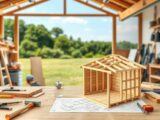Essential Wooden House Buying Checklist – UK Guide

This guide is a concise, practical wooden house buying checklist aimed at buyers across the United Kingdom. It exists to reduce risk and clarify the technical and legal requirements when buying a timber home. Use this timber home buying guide to understand inspections, planning, construction types, maintenance and long‑term running costs.
The intended audience includes owner‑occupiers, investors, self‑builders and those considering relocatable or permanent timber homes. The advice is relevant to England, Wales, Scotland and Northern Ireland, while noting that planning decisions and Building Regulations can vary by nation.
The structure of the guide follows a logical, step‑by‑step flow. You will find actionable inspection items, clear questions to ask suppliers and surveyors, and regulatory checkpoints. The timber home buying guide covers sustainability and safety — from fire protection to moisture management — and offers a practical approach to commissioning surveys and negotiating repairs.
This wooden home checklist UK sets expectations for a thorough process. It begins with site and structural checks, moves through planning and building regulation matters, and concludes with surveying and the final wooden house purchase UK decision. Follow each section to make a well‑informed buying a timber house choice.
Inhaltsverzeichnis
Key Takeaways
- Use this wooden house buying checklist to lower risk and clarify obligations.
- Advice suits owner‑occupiers, investors and self‑builders across the UK.
- Expect step‑by‑step checks: site, structure, planning and safety.
- Ask suppliers and surveyors specific, written questions about materials and warranties.
- Consider long‑term costs such as maintenance, energy and insurance.
Introduction to buying a wooden house in the UK
Wooden houses are moving from niche to mainstream across Britain. The wooden homes UK popularity stems from strong sustainability credentials, rapid build times for timber-frame systems and improved thermal performance when designs are right. Major UK developers and manufacturers, including Berkeley Group projects and specialist timber firms, now offer timber-frame options that rival traditional masonry in quality and finish.
Why buyers choose timber
Buyers cite clear benefits of timber houses. Lower embodied carbon makes timber attractive for low-impact living. Prefabrication shortens site time and reduces waste. When well insulated and ventilated, timber homes deliver good energy performance and occupant comfort.
Why wooden homes are gaining popularity in the United Kingdom
The market shift reflects wider demand for eco-friendly homes and tighter building standards. Advances in preservative treatments and glazing mean timber properties meet modern durability and weatherproofing expectations. Contemporary designs from companies such as Stommel and other UK suppliers show timber can suit both rural and urban settings.
Overview of what to expect in the buying process
Expect several stages in the buying wooden home process. Start with site selection and planning checks. Seek pre-application advice from the local planning office. Commission technical inspections that include structural and moisture-focused checks for timber. For new-build purchases, review developer warranties and snagging lists. For self-builds or kit homes, factor in design, contractor selection and on-site supervision.
How this guide will help you make an informed purchase
This timber house checklist introduction sets out practical steps to use alongside professional surveys. The guide covers site inspection points, comparisons of construction types, and regulatory checkpoints for England, Wales, Scotland and Northern Ireland. It also advises on hiring surveyors, structural engineers and timber specialists, and on interpreting reports to support offers and negotiations.
Readers should use the checklist with paid surveys and consider long-term maintenance and insurance for timber properties before committing to purchase.
wooden house buying checklist
This checklist helps buyers spot risks and verify quality when viewing a timber property. Use it at the first viewing and again during a professional survey. Keep a photographic record and clear notes for each visit.
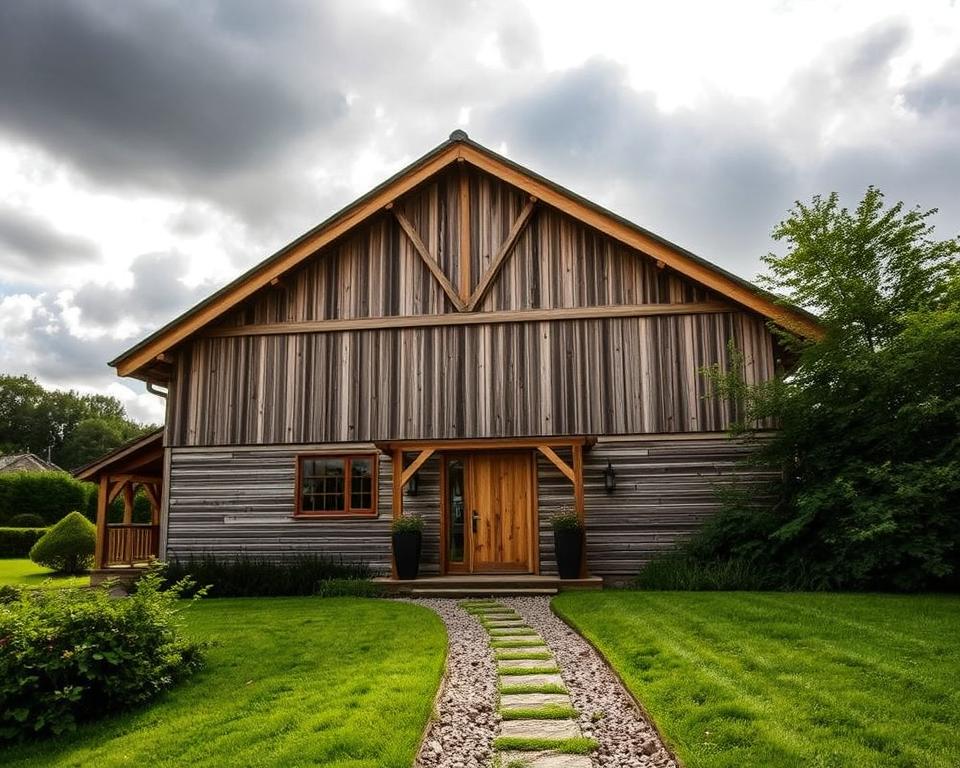
Site inspection items to include on your checklist
Check access and road condition for delivery of materials and emergency access. Note orientation for solar gain and shading from neighbouring buildings.
Confirm boundary lines, rights of way and proximity to trees. Large roots can affect foundations and timber health.
Assess slope, topography and visible drainage. Look for signs of previous flooding, standing water or blocked drains.
Record nearby noise or industrial sources that could affect amenity or resale value. Take photos of any immediate visual defects.
Structural and material checks specific to wooden construction
Inspect foundations, damp-proof courses and separation from ground to guard against rising damp. Note any cracks or uneven settlement.
Examine the timber frame or log walls for deformation, open or loose joints, and movement at corners and junctions. Test windows, doors and roof junctions for shrinkage and gaps.
Look for corrosion of metal fixings and connectors. Confirm presence of preservative treatments and quality of external airtightness and sealing details.
Legal and planning considerations to verify
Confirm planning status and any conditions attached to the consent. Verify Building Regulations approvals and completion certificates are available.
Check warranties such as NHBC, Premier Guarantee or manufacturer guarantees where applicable. For kit or modular homes, request as-built drawings, structural calculations and factory production certification.
Investigate listed building or conservation area restrictions, easements, covenants and local authority tree protection orders. Always request documentary evidence for items that are not visually obvious.
The short checklist below summarises key actions to take during viewings and surveys.
| Area | What to check | Action |
|---|---|---|
| Access & Roads | Road surface, turning, delivery access | Photograph access; note suitability for construction traffic |
| Orientation & Site | Solar gain, shading, slope | Record sun path; check for shading that affects heating |
| Boundaries & Rights | Fences, hedges, public rights of way | Confirm legal boundary lines and rights with seller |
| Vegetation & Trees | Proximity, root risk, canopy overhang | Obtain council tree protection info; photograph root zones |
| Drainage & Flooding | Surface water, drains, historical flooding signs | Check local flood maps and take photos of drainage |
| Foundations & DPC | Separation from ground, visible cracks, damp evidence | Ask for structural records; include in timber house inspection checklist |
| Timber Fabric | Frame straightness, joint condition, preservative treatment | Note deformations and loose joints; request preservative data |
| Metal Fixings | Corrosion, suitable connectors, tie plates | Inspect connectors closely; include findings in survey report |
| Openings & Seals | Windows, doors, roof junctions for gaps | Test for draughts; photograph gaps and movement |
| Regulatory Paperwork | Planning status, Building Regs, completion certs | Obtain copies and verify with local authority as part of legal checks timber house |
| Warranties & Certification | NHBC, Premier Guarantee, manufacturer guarantees | Request documents and confirm coverage periods |
| Modular/Factory Data | As-built drawings, structural calculations, production certs | Ask vendor for factory certification and include in timber house inspection checklist |
Use this wooden house buying checklist items list during viewings and on-site inspections. Repeat items during a full survey to ensure nothing is missed.
Understanding types of wooden house construction
Choosing a wooden home means weighing distinct systems, each with its own build method, thermal behaviour and upkeep. This short guide describes common approaches and practical implications for buyers in the UK.
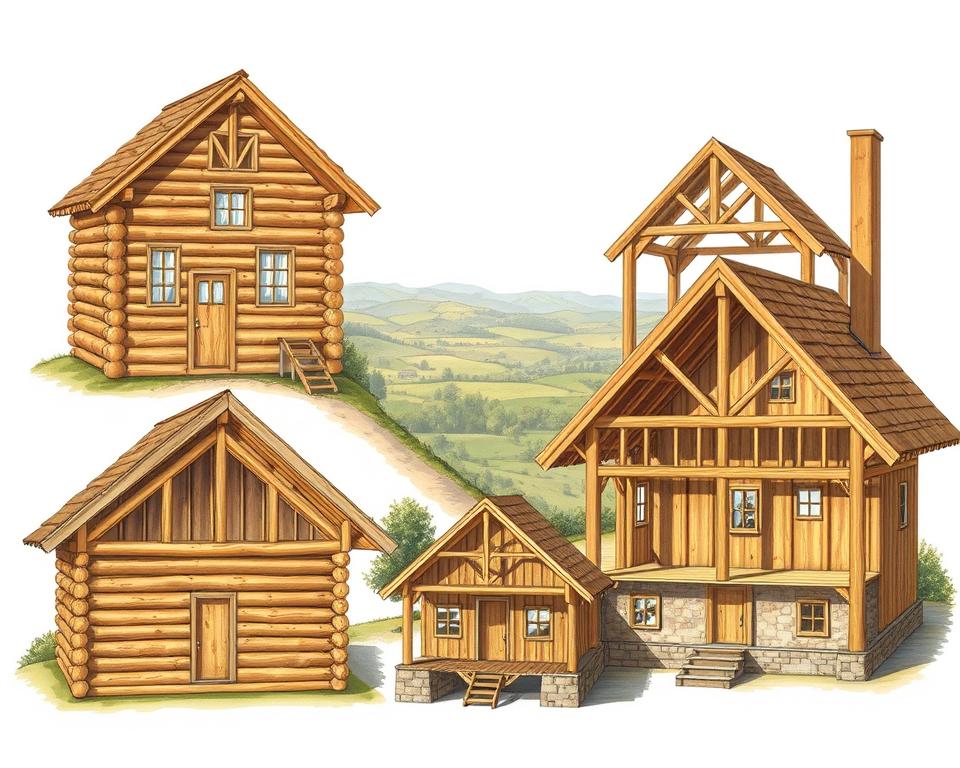
Timber frame, SIPs, CLT and solid log systems
Traditional timber frame uses studwork with external sheathing and internal insulation. It relies on a breathable envelope and ventilated cavities to control moisture. Structural insulated panels (SIPs) are factory-made panels that combine insulation and structure for fast assembly and strong U-values.
Cross-laminated timber (CLT) provides mass timber panels for load-bearing walls and floors. CLT suits multi-storey projects where speed and modern aesthetics matter. Solid log and post-and-beam systems offer a more vernacular look. They perform as thermal mass when dried and detailed correctly.
Factory-produced modular and kit homes come with quality-controlled components. Site-built frames allow more on-site adjustment but need careful on-site moisture protection during construction.
Comparing timber frame vs log home and engineered wood systems
Timber frame vs log home presents clear contrasts. Timber frames give flexible layouts and excellent insulation cavities. Log homes give character and thermal mass but need precise drying and seal maintenance.
Engineered wood systems such as SIPs and CLT offer predictable performance and rapid erection. They reduce waste and often include manufacturer warranties. Buyers should request datasheets and design-life information before purchase.
Pros and cons for UK climates
SIP and timber frame systems excel at airtightness and low heat loss. They demand robust moisture management in the UK’s maritime climate, with ventilated cavities and breathable membranes to avoid condensation.
CLT brings structural robustness and speed. Joints and connections must be detailed to prevent water ingress and allow drying. Log homes cope well with diurnal temperature swings, yet external weatherproofing is essential on exposed sites.
Typical lifespan, maintenance and UK timber house lifespan
When designed and maintained correctly, wooden dwellings can last generations. UK timber house lifespan depends on species, preservative treatment, cladding, roof detailing and site exposure.
Routine tasks include re-staining or re-sealing external timber every 5–15 years depending on finish, checking fixings and flashings, and replacing sealants and breathable membranes as required. Confirm preservative methods such as vacuum treatment or approved chemical systems for relevant components.
Practical buyer checklist
- Request manufacturer datasheets and warranty details for engineered wood systems and kit components.
- Ask for a design-life estimate and a maintenance schedule that covers coatings, joints and sealants.
- Check site assembly methods and how the builder will protect the frame from moisture during construction.
- Verify timber species and preservative treatments for long-term durability.
| System | Strengths | Weaknesses | Typical maintenance |
|---|---|---|---|
| Timber frame | Flexible design, good insulation cavities, quick build | Needs ventilated cavities and airtight detailing to avoid moisture | Periodic membrane checks, re-seal external timber every 5–12 years |
| SIPs (engineered wood systems) | High thermal performance, factory quality, rapid assembly | Requires precise joint detailing and moisture protection | Inspect panel joints and external finishes; replace sealants as needed |
| CLT | Structural robustness, modern finish, fast erection | Joint detailing critical; panels require careful protection while wet | Check connections, protective coatings and flashing annually |
| Log / post-and-beam | High thermal mass, traditional appeal, long-lasting if dry | Sensitive to moisture; requires precise drying and weatherproofing | Re-staining or re-sealing every 5–15 years; inspect chinks and seals |
Location and site suitability for a wooden home
Choosing the right plot is as important as the design of the building. Assessing wooden home site suitability early saves time and reduces surprise costs. A careful check of site features guides foundation design and long-term upkeep for timber buildings.

Assessing ground conditions and drainage
Commission a ground investigation or site soils report to confirm bearing capacity and identify peat, organic soils or high water tables. These factors determine foundation type and cost. For a timber house, raised or isolated foundations often suit weak soils and reduce damp risk.
Consider drainage routes and surface water management. Poor drainage can increase moisture at the base of the structure and affect longevity. Confirm soakaway suitability and whether impermeable surfacing will need additional drainage work.
Flood risk, local planning policies and conservation areas
Check flood maps from Environment Agency, Natural Resources Wales, SEPA or Rivers Agency to gauge flood risk timber properties UK. Use this evidence to decide on avoidance, raised finished floor levels or resilient internal materials.
Local planning authorities may restrict development in flood-prone zones or conservation areas. Seek pre-application advice to learn policy expectations and acceptable mitigation measures. Early engagement helps shape design choices that planning officers will support.
Access, services and connectivity considerations
Evaluate vehicular access for delivery of large panels, cranes and materials. Narrow lanes or overhead constraints add cost and logistical complexity during construction.
Confirm proximity to mains water, electricity, gas and sewer connections. Remote sites often need long service runs, private water or septic tanks. Contact providers such as UK Power Networks, Scottish and Southern Electricity Networks or United Utilities to check capacity and connection charges.
Review broadband and mobile coverage for household needs and remote working. Verify whether roads and sewers are adopted by the local authority. Consider site security and the impact on neighbours when planning access and storage of materials.
Planning permission and building regulations
Buying a timber home in the UK means navigating two distinct but linked processes: planning consent and Building Regulations compliance. Early clarity on planning permission wooden house issues and Building Regulations timber construction UK will speed decisions and reduce risk. Seek pre-application advice and confirm the timber house planning requirements that apply to your plot.

When planning consent is likely to be needed
Planning permission is usually required for a new build, a change of use or substantial extensions. Projects in conservation areas or involving listed buildings attract stricter scrutiny. Small outbuildings and modest extensions can sometimes fall under permitted development but limits vary by local plan and by property type.
Some kit and modular homes on private plots still need full planning permission. Check local policy early. This avoids surprises when contracts progress.
Building Regulations and timber-specific rules
England and Wales use Approved Documents covering structure, fire safety, conservation of fuel and power and moisture control. Scotland relies on Technical Handbooks. Northern Ireland refers to Technical Booklets. Each regime requires documented evidence that structural calculations, U-values and ventilation meet standards.
Timber buildings raise particular issues. Structural stability must be demonstrated, often via calculations from a Chartered Structural Engineer or a registered timber frame manufacturer. Fire safety under Approved Document B and moisture management standards are critical for combustible materials.
Working effectively with planning officers
Engage planning officers timber home contacts early for pre-application advice. That discussion clarifies local constraints and highlights required supporting documents such as a design and access statement or a heritage statement.
RIBA-accredited architects or experienced planning consultants can prepare drawings and handle consultations. They help negotiate bespoke conditions and advise on how to meet timber house planning requirements in sensitive locations.
Practical steps to protect the buyer
Where possible, secure planning permission and Building Regulations approvals before exchange of contracts. If that is not practical, include conditional clauses in the purchase contract to protect against refusal or onerous conditions.
Keep records of correspondence with planning officers and building control. These documents help when applying for mortgage consent, arranging insurance and proving compliance to future buyers.
Structural integrity and timber quality checks
Before you commit to a purchase, carry out focused timber structural checks that cover foundations, framing and connections. A brief visual review can flag obvious issues. For any concerns, commission a qualified surveyor with timber experience to follow up.
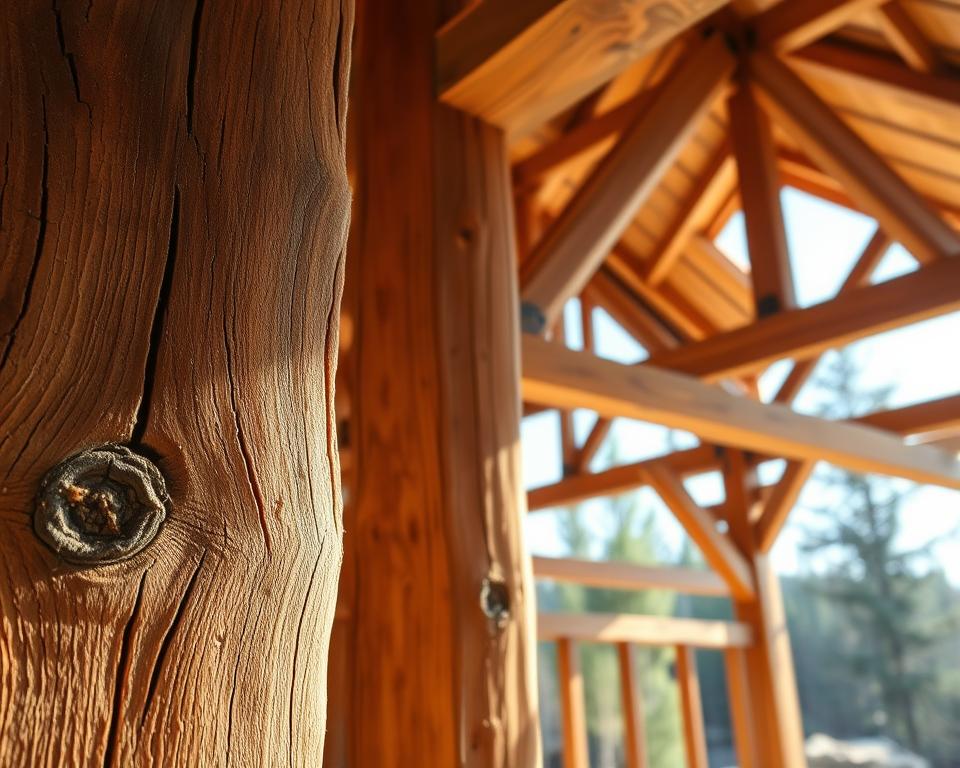
Key elements to inspect: foundations, frame, joints and fixings
Check foundations for cracking, signs of water ingress and correct damp-proof course separation. Look for level and plumb walls, bowed studs or sagging roof trusses. Inspect wall plates, floor joists and connections for engineered fixings and bolting.
Ensure structural connectors are galvanised or stainless steel and that bracing is adequate. A timber fixings inspection should verify that screws, brackets and bolts are corrosion-resistant and correctly installed.
Identifying signs of rot, insect damage and moisture ingress
Look for soft, spongy wood, discolouration or a musty smell as signs of fungal decay. Wet rot and dry rot can present mycelium or honeycombed timber. Small round holes and powdery frass point to insect activity.
Use a moisture meter to check timber moisture content. Readings above 20% often warrant further testing. If infestation or decay is suspected, instruct a specialist in timber conservation or an entomologist to assess the rot and insect damage timber house.
Confirming quality of treated timber and warranties
Ask for treatment certificates for preservative or pressure-treated timbers and confirm species where relevant, such as Scottish larch or European spruce. Verify conformity with applicable British Standards for treatment and durability.
Request copies of timber treatment warranties and check manufacturer warranty periods. For new builds, confirm any NHBC or Premier Guarantee cover and whether warranties are transferable. Keep laboratory test results and maintenance obligations recorded in the sale contract for future reference.
Insulation, thermal performance and energy efficiency
This part examines how insulation, airtightness and energy ratings shape comfort and running costs in wooden homes. It explains common materials, what U-values tell you and why an EPC wooden house matters when assessing long-term performance.

Types of insulation suitable for wooden homes
Timber house insulation choices include mineral wool, cellulose and wood fibre. These materials suit traditional timber frames and more modern systems such as SIPs and CLT.
PIR boards and rigid phenolic or polyurethane boards work where cavity space is tight. Wood fibre gives a breathable layer that helps manage moisture in timber elements.
Careful detailing is essential. A vapour control layer should sit with breathable external membranes to avoid trapped moisture between layers and to protect the frame.
Assessing U-values, airtightness and condensation risk
U-values timber construction displays the heat loss of walls, roofs and floors. Lower U-values mean better thermal retention. Well-insulated timber frames, SIPs and CLT can reach low U-values while keeping a slim build-up.
Airtightness testing, typically a blower door test, proves how well the building envelope performs. Good airtightness reduces heat loss and improves comfort.
Thermal bridging at junctions creates cold spots and raises condensation risk. Correct sealing, continuous insulation and properly fixed vapour control layers limit interstitial condensation and keep the timber dry.
Energy performance certificates and long-term running costs
Check the EPC wooden house rating before purchase. The certificate gives a snapshot of likely heating demand and efficiency measures on the existing property.
Compare running costs for a timber home against masonry equivalents. Timber buildings often need less energy when fabric-first measures are applied and when paired with low-energy heating such as heat pumps.
Consider lifecycle costs, not just the purchase price. Seek design U-value calculations and evidence of airtightness testing. Provision for MVHR or a heat-pump-ready system helps future-proof energy performance in a thermal performance wooden home.
Moisture management and damp prevention
Good moisture control matters in wooden homes. Careful design and ongoing checks reduce rot risk and keep living spaces healthy. This short guide outlines key design features, ventilation choices and routine checks that help with timber moisture management and damp prevention wooden homes face in the UK climate.

Design features that prevent moisture build-up
Ventilated cavities behind cladding stop trapped water. Breathable membranes allow vapour to escape while blocking liquid water. Drip edges and raised thresholds shed splash water away from timber bases.
Adequate roof overhangs protect walls from driving rain. Protected junctions at ground level and correct detailing at windows, doors and eaves prevent water ingress. Fit durable flashings and sealants at transitions to reduce long-term maintenance.
Ventilation strategies and breathable materials
Passive ventilation, such as trickle vents and designed air paths, works well with timber. Mechanical extract and MVHR systems control humidity in kitchens and bathrooms. Aim for balanced airflow to avoid local condensation.
Choose vapour-open insulation like wood fibre and internal finishes such as lime plaster or clay-based products. Breathable materials timber construction encourages moisture diffusion and avoids impermeable layers next to timber that trap damp.
Routine checks and signs of moisture-related problems
Inspect gutters, flashings and downpipes twice yearly and after storms. Look for blocked cavities, staining, timber darkening, raised indoor humidity and musty odours. These signs point to moisture issues needing attention.
Use a moisture meter to record readings over time. Keep a simple log of measurements and visual checks. If readings remain high or if decay appears, engage a timber specialist for targeted advice on damp prevention wooden homes require.
Maintenance checklist
- Clear gutters and downpipes twice yearly to keep water flowing.
- Inspect cladding and sealants annually; repair splits or gaps promptly.
- Check flashing and roof integrity after severe weather events.
- Service ventilation and MVHR per manufacturer guidance to maintain performance.
- Record moisture meter readings quarterly and act on rising trends.
Foundations, groundworks and site drainage
Choosing the right groundwork strategy protects a wooden home from the start. Good design keeps timber clear of damp soil, manages surface water and flags ground risk early. Buyers should seek clear advice on timber house foundations, groundworks for wooden homes and drainage timber property before exchange of contracts.

Appropriate foundation types for timber buildings
Strip foundations suit uniform loads on firm soils. Pad and beam foundations work well for point loads when columns support a frame. Piled foundations or deeper pad systems become necessary on weak or compressible strata. Suspended timber ground floors with concrete edge beams keep joists above ground moisture and create ventilated voids beneath the floor.
Why raised or piled solutions matter
Raising the timber structure prevents direct contact with saturated soils. Piled solutions transfer loads to stable layers, reducing movement. Damp-proof membranes paired with ventilated voids cut moisture risk and extend the life of timber components.
Drainage and soakaway considerations for UK rainfall
Design site drainage to cope with intense UK rain. Sustainable drainage systems (SuDS), permeable paving and swales reduce runoff to urban drains. Soakaways must be sized from infiltration tests. Local permitting can be required for discharge to watercourses, so check council rules early.
Practical routing of surface water
Keep surface water away from foundations and timber elements. Direct runoff towards soakaways or attenuation features. Protect below-ground timbers and cladding junctions from splashback and pooling to avoid decay.
Checking for subsidence risk and ground stability
Signs of subsidence include new cracks in walls, doors that jam and leaning chimneys. Sites on clay, made ground or former mining areas carry greater risk. Commission a geo-environmental report to identify shrink-swell clays or voids beneath the site.
When to involve specialists
Where differential settlement or contaminated fill is possible, ask a structural engineer for foundation options. Reinforced raft slabs, deeper footings or piled solutions can mitigate movement. Budget for remedial groundworks when reports recommend them.
Practical buyer checklist
- Obtain ground investigation and infiltration test results before exchange where possible.
- Confirm chosen timber house foundations are suitable for site soil and loadings.
- Ensure groundworks for wooden homes include damp-proof membranes and ventilation under suspended floors.
- Verify soakaway design and permits for discharge to watercourses.
- Commission geo-environmental advice if subsidence risk timber house UK indicators appear.
Roofing, external cladding and weatherproofing
Choosing the right finishes for a wooden home affects durability, appearance and running costs. This short guide outlines practical roofing choices, popular cladding options wooden homes use, and simple weatherproofing timber structure measures. It explains what buyers should inspect, and what to ask manufacturers and installers.
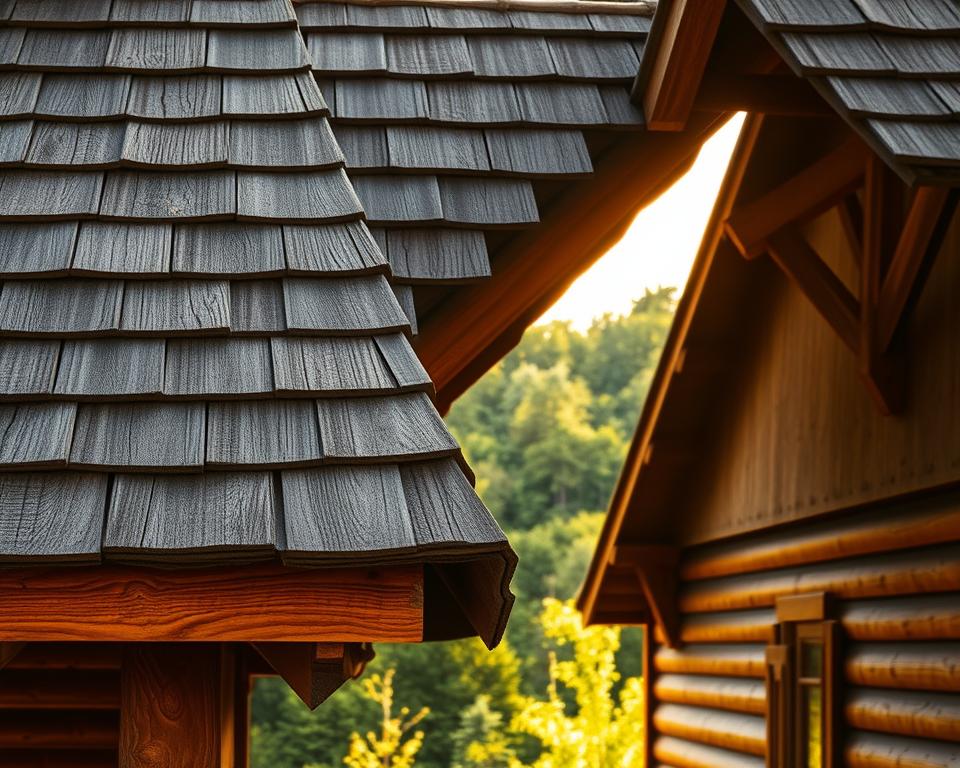
For roofs, pitched systems remain the safest match for timber frames. Natural slate, clay tile and concrete tile give long service lives and shed rain effectively. Standing seam metal suits contemporary designs and offers low maintenance. For low-pitch roofs, single-ply membranes perform well when fitted with correct substrate and fall.
Design must include ventilation of rafter voids and robust eaves detailing. Stressed-skin systems such as SIPs need careful edge flashing and airtight joints to avoid moisture ingress. Confirm product datasheets and warranties before signing contracts.
The market for cladding is broad. Natural timber cladding from treated larch or cedar gives a warm look with reversible repairs. Accoya and other modified woods resist decay and reduce cladding maintenance UK demands. Engineered timber boards provide dimensional stability.
Non-wood alternatives include fibre-cement, composite panels such as Trespa, and metal rainscreen systems. Brick slips or insulated render over a substrate suit those wanting a masonry appearance while keeping timber structure benefits. Rainscreen cavities help ventilate the façade and reduce wetting of the primary timber element.
Finishes matter. Microporous stains and oils let timber breathe while repelling moisture. Paints give colour with increased maintenance at joints. Manufacturers’ maintenance schedules show recommended re-coat intervals and compatible products.
Maintenance and lifespan vary by material. Softwood cladding typically needs re-coating every 5–10 years. Accoya and chemically modified woods can go longer between treatments. Fibre-cement and metal claddings often need only occasional checks, though sealant and fixings should be inspected regularly.
Inspect joints, end-grain details, fixings and seals annually. Replace damaged boards promptly to protect the weatherproofing timber structure. Ask for warranty certificates, product datasheets and a written maintenance plan from installers.
| Component | Typical materials | Expected service life | Key maintenance tasks |
|---|---|---|---|
| Roof covering | Slate, clay tile, concrete tile, standing seam metal, single-ply membrane | 30–100 years (tiles/slate), 30–60 years (metal), 20–30 years (single-ply) | Check flashings, clear gutters, inspect membranes at penetrations |
| Timber cladding | Larch, cedar, Accoya, engineered timber | 10–25+ years depending on species and treatment | Re-coat as recommended, replace damaged boards, inspect ventilation gaps |
| Composite / fibre-cement | Trespa-style panels, fibre-cement boards | 30–50 years | Inspect fixings, check sealants, clean surfaces to remove debris |
| Rainscreen system | Ventilated cavity with chosen outer cladding | Depends on outer cladding; cavity prolongs primary structure life | Ensure cavity clearances, check breather membranes, maintain drainage paths |
Services, utilities and sustainable systems
Setting up services for a timber property needs care. Early planning prevents delays and unexpected costs when arranging timber house utilities. Start by contacting local water, gas and electricity suppliers as soon as contracts exchange. Typical lead times vary from two to eight weeks. Remote sites or long service runs will add cost for cabling, trenching or pump installations.
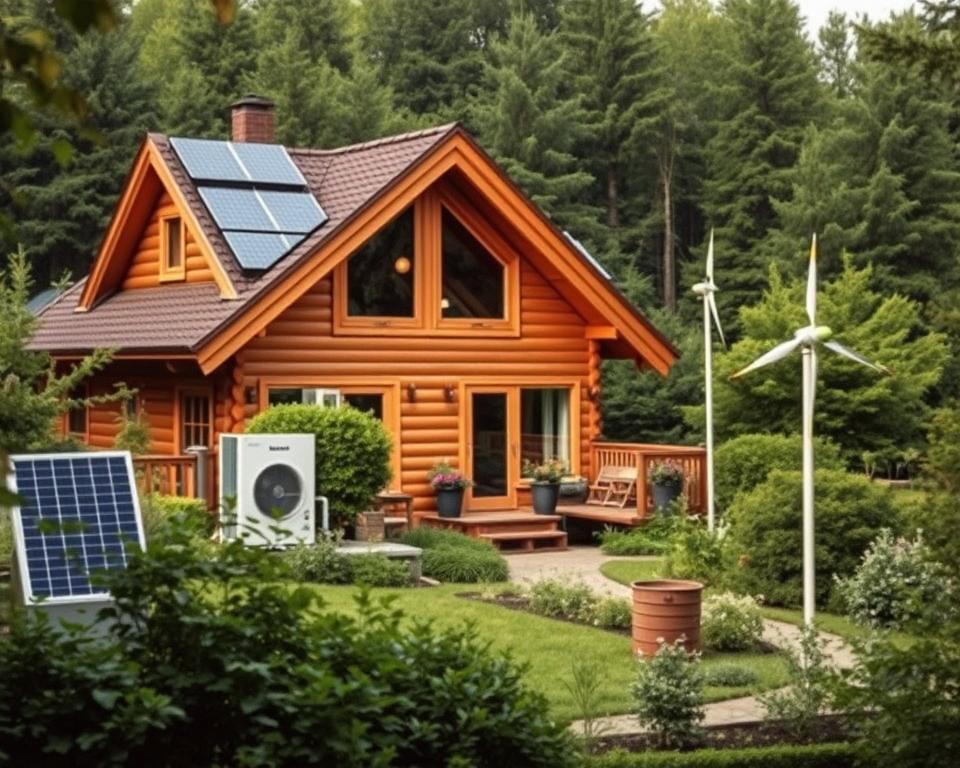
For mains connections, apply through your regional water company and the local distribution network operator for electricity. Gas connections require an assessment by a Gas Safe registered engineer. Safety matters more in wooden buildings. Ensure combustion appliances have correct flues and clearances. Gas boilers or stoves must meet Building Regulations and be installed with adequate fire-stopping and clearance from timber elements.
Low-carbon choices suit timber homes well. A sustainable systems timber home often combines good fabric insulation with renewables. Air-source and ground-source heat pumps work with well-insulated walls and floors. Heat pumps wooden house installations typically need space for an external unit or borehole, plus compatible controls for efficient operation.
Photovoltaic panels and solar thermal systems are common. A solar timber home UK setup can reduce grid demand and cut bills. Consider battery storage to capture excess PV output for evening use. Rainwater harvesting for WC flushing and garden irrigation lowers mains demand and pairs well with water-efficient fittings.
Smart controls improve performance and comfort. Fit energy monitoring and thermostatic zoning to track use and optimise systems. Off-the-shelf smart meters, NIBE or Daikin-compatible controllers, and dedicated eco-home controllers allow remote monitoring of heat pumps wooden house installations and battery charge. Integrate MVHR ventilation controls and leak-detection sensors for water services to protect the timber fabric.
Choose accredited installers and certified products. Look for MCS certification on renewables and TrustMark accreditation for installers. Manufacturers such as Viessmann, Mitsubishi Electric and Sonnen offer tested systems with service networks across the UK. Factor in operation and maintenance needs, warranties and routine checks to secure long-term performance.
Practical budgeting is essential. Include site works, trenching, connection fees and any required structural alterations for flues or plant. Early engagement with suppliers, a clear fabric-first strategy and the right accreditation will help deliver safe, efficient timber house utilities and a resilient sustainable systems timber home.
Fire safety and regulations for wooden properties
Timber homes offer warmth and efficiency. Fire safety must sit at the heart of any purchase decision. Buyers should understand how fire-resistant materials, building rules and practical measures work together to protect occupants and property.

Fire-resistant treatments and materials for timber structures
Intumescent coatings form a thin film that swells when heated and protects timber by slowing temperature rise. Fire-retardant preservative treatments soak into timber and reduce flammability for prolonged periods. Engineered timbers such as cross-laminated timber (CLT) char on the surface in a predictable way, which can preserve structural integrity for a set period.
Where risk is higher, non-combustible cladding or dedicated fire barriers may be required. This is common in multi-storey blocks, mixed-use developments and sites close to other buildings. Specifying the right materials helps meet both performance needs and the expectations of insurers.
Legal requirements and recommended safety measures
England and Wales refer to Approved Document B for guidance on means of warning, internal fire resistance and escape routes. Scotland follows the Scottish Technical Handbooks, which set out compartmentation and detection standards. Northern Ireland publishes its own fire safety guidance for dwellings. All documents include extra controls for buildings above certain heights or with mixed uses.
Local planning officers and building control will check compliance during approvals. New-build timber homes should have a clear fire strategy document and certificates that confirm fire-resistant elements meet the specified performance.
Escape routes, alarms and insurance implications
Fit hardwired smoke alarms that interlink across the dwelling and install heat detectors in kitchens. Design clear, unobstructed escape routes and rehearse evacuation plans with householders. External fire-fighting access and compartmentation add layers of protection for larger properties.
Insurers often request evidence of fire-mitigation measures. Some underwriters may apply higher premiums or exclusions if untreated timber elements are present. Buyers should consult insurers early and obtain written confirmation that the proposed fire treatments and strategy satisfy underwriting requirements for timber house insurance fire.
Request a copy of any fire strategy, test reports and compliance certificates before exchange of contracts. Keeping documentation with the sale pack helps ensure compliance with fire regulations wooden properties UK and reassures lenders, neighbours and insurers.
Surveying and professional inspections
A proper survey brings clarity on condition, costs and risk when buying a wooden home. Choose the right level of inspection early. Commission targeted tests where the survey flags unusual timber detail, damp or suspected insect activity.

Types of survey suitable for wooden houses
RICS Level 1, the Condition Report, suits modern timber homes in good repair. It gives a brief overview of urgent problems and obvious defects.
Level 2, the HomeBuyer Report, is a mid-range option that highlights serious issues and includes a valuation. Use this when you need more detail but the building appears generally sound.
Level 3, the Building Survey, is a full inspection. This is often essential for older timber properties, unusual construction or where defects are suspected. Ask for specialist timber surveys, damp and mould testing, plus BBA or TRADA-recommended checks if engineered components are present.
Choosing surveyors experienced with timber construction
Select RICS-registered surveyors with proven experience of timber-frame, CLT and log systems. Look for membership of the Structural Timber Association and request client references.
Ask to see sample reports to judge clarity and the level of technical detail. For complex structural issues consider appointing a Chartered Structural Engineer with timber expertise.
Interpreting survey reports and negotiating repairs
When interpreting timber survey report content, separate immediate safety defects from routine maintenance items. Highlight urgency and likely costs.
Obtain costed quotes from builders experienced in timber repairs before you negotiate. Use survey findings to negotiate price reductions, require seller-funded repairs or include a repair schedule as a contract condition.
Specify remedial scope, materials and warranties in any agreement. Commission moisture mapping, boroscopy or lab testing if suggested by the survey. Keep all reports for mortgage, insurance and future resale needs.
Conclusion
This wooden house buying checklist conclusion brings together the practical steps every buyer in the UK should follow. Prioritise site suitability and ground drainage, carry out rigorous moisture and structural checks, and understand the differences between timber frame, log and engineered systems. Confirm planning permission and Building Regulations compliance early to avoid costly delays.
Use the timber home purchase checklist wrap-up at viewings and commission appropriate surveys from RICS-accredited or timber-experienced surveyors. Seek pre-application planning advice for new builds, and request documentary evidence such as treatment certificates, warranties and as-built drawings before exchange. Budget realistically for ongoing maintenance and any necessary groundworks.
Adopt a pragmatic, evidence-led approach that balances the sustainability and speed-of-build advantages of timber with careful due diligence on moisture management, fire safety and regulatory compliance. For support, contact the Royal Institution of Chartered Surveyors, the Structural Timber Association and your local authority planning department to guide you through the buy timber house UK summary and ensure a secure purchase.
FAQ
What is the purpose of this Essential Wooden House Buying Checklist?
This checklist is a comprehensive, UK-focused guide designed to reduce risk and clarify technical and legal requirements when buying a wooden house. It guides buyers through inspection items, planning and Building Regulations checkpoints, timber construction types, moisture and fire safety considerations, maintenance and running costs, and commissioning professional reports to support an informed purchase decision.
Who is this guide intended for?
The guide is aimed at owner-occupiers, investors, self-builders and those considering relocatable or permanent timber homes across England, Wales, Scotland and Northern Ireland. It recognises regional differences in planning and Building Regulations and provides practical advice relevant to new-builds, existing timber properties and kit or modular homes.
What key areas does the checklist cover?
The checklist covers site inspection items, structural and material checks specific to timber construction, legal and planning verifications, types of timber systems and their pros and cons, foundations and groundworks, moisture management, insulation and energy performance, roofing and cladding, services and sustainable systems, fire safety, and surveying requirements.
Which timber construction systems are explained in the guide?
The guide explains traditional timber frame, structural insulated panels (SIPs), cross-laminated timber (CLT), solid log and post-and-beam systems, plus factory-produced modular and kit homes. It outlines typical detailing, moisture-management needs, durability and maintenance expectations for each system.
What should I check during a site inspection for a wooden house?
Check access and road condition, orientation and solar gain, boundary lines, neighbouring trees and vegetation, slope and topography, visible drainage, signs of past flooding and proximity to noise or industrial sources. Take photographs and notes, and repeat checks during a detailed survey visit.
What timber-specific structural checks are essential?
Inspect foundations and the separation between timber and ground, frame plumb and alignment, condition of joints, corrosion of metal fixings, preservative treatments, deformation, and signs of movement at windows, doors and roof junctions. Use moisture meters where appropriate and request treatment certificates and manufacturer data.
How do I verify planning status and Building Regulations compliance?
Request planning permission documents and any imposed conditions from the seller or developer. Verify Building Regulations approvals and completion certificates. For new-builds or conversions, ask for structural calculations, as-built drawings, factory production certification for modular elements and any warranties such as NHBC or Premier Guarantee.
What ground investigations should I commission before buying?
Commission a ground investigation or soils report to confirm bearing capacity, peat or organic layers, water table levels and shrink–swell clay presence. The report informs foundation design and cost estimates and helps decide on raised, piled or suspended floor solutions to protect timber elements.
How should flood risk and drainage be assessed?
Use Environment Agency, Natural Resources Wales, SEPA or Rivers Agency maps to check flood zones. Assess surface water management and SuDS options, order soakaway infiltration testing if needed, and ensure site drainage routes surface water away from timber elements. Consider raised finished floor levels and resilient detailing where risk exists.
What insulation and airtightness standards apply to timber homes?
Timber systems commonly use mineral wool, wood-fibre, cellulose, PIR or phenolic boards. Request U-value calculations and evidence of airtightness testing (blower-door). Ensure correct vapour control layers and breathable membranes are detailed to avoid interstitial condensation and to achieve low heat loss.
How should moisture management be detailed for timber construction?
Look for ventilated rainscreen cavities, breathable membranes, drip edges, raised thresholds and well-detailed window and eaves junctions. Confirm ventilation strategy—passive or MVHR—and use breathable internal finishes where appropriate. Regular inspections and moisture monitoring are vital to detect ingress early.
What foundation types suit timber buildings on varied UK soils?
Options include strip foundations, pad-and-beam, piled foundations for weak soils, and suspended timber ground floors with concrete edge beams. Raised or piled solutions reduce timber contact with saturated soils. Foundation choice should follow ground investigation recommendations and structural engineer input.
Which roofing and cladding options pair best with timber structures?
Durable pitched coverings (slate, clay or concrete tiles, standing-seam metal) and correctly detailed low-pitch membranes work well. Cladding options include treated larch, cedar, Accoya, engineered boards, fibre-cement and ventilated rainscreen systems. Request product datasheets, warranties and maintenance schedules from suppliers.
What sustainability measures are recommended for timber homes?
Combine fabric-first design with low-carbon systems: heat pumps (air or ground source), photovoltaic panels, battery storage, MVHR and rainwater harvesting. Seek MCS certification for renewables and installers accredited by TrustMark. Energy monitoring and smart controls improve performance and long-term running costs.
What fire-safety measures must I consider for a wooden property?
Ensure compliance with Approved Document B (England/Wales), Scottish Technical Handbooks or Northern Ireland guidance. Use appropriate fire-resistant treatments, intumescent coatings or barriers where required, provide interlinked alarms, consider compartmentation and ensure accessible escape routes. Obtain fire strategy documents for new-builds.
Which type of survey is suitable for timber houses?
For most timber properties, a Level 2 HomeBuyer Report may suffice for newer, standard builds. For older, unusual or suspect properties, commission a Level 3 Building Survey. Consider specialist timber surveys, damp/mould inspections, moisture mapping and boroscopy where indicated, and appoint RICS-registered surveyors experienced in timber construction.
How do I choose surveyors and specialists with timber expertise?
Select RICS-registered surveyors or Chartered Structural Engineers with demonstrable experience of timber-frame, CLT or log systems. Check memberships such as the Structural Timber Association, ask for sample reports and references, and consider timber consultants for decay or pest investigations.
How can survey findings be used in negotiations?
Distinguish urgent structural or safety defects from routine maintenance items. Obtain costed remedial quotes from timber-experienced contractors and use these figures to negotiate price reductions, require seller-funded repairs or include repair schedules and warranties as contract conditions.
What warranties and certificates should I request?
Request treatment certificates for preservative-treated timber, factory production controls for modular elements, structural calculations, as-built drawings, Building Regulations completion certificates and warranty documentation such as NHBC, Premier Guarantee or manufacturer guarantees for kit homes. Confirm warranty transferability on sale.
How often should external timber finishes be maintained?
Maintenance intervals depend on species and finish. Softwood cladding typically needs re-coating every 5–10 years. Modified woods like Accoya and high-quality stains may extend service life. Inspect joints, fixings and sealants annually and follow manufacturer maintenance schedules to prevent moisture ingress.
What are typical signs of timber decay or infestation to watch for?
Look for soft, spongy or crumbling wood, discoloration, fungal mycelium, honeycombed timber, woodworm holes and frass. Doors or windows that stick, damp or musty odours and elevated moisture meter readings (>20%) indicate potential problems. Commission specialist testing and lab analysis if decay is suspected.
When should I obtain a ground investigation or geo-environmental report?
Obtain a ground report before exchange when the site shows indicators of problematic soils (peat, made ground, shrink–swell clay), on sloping sites, or where subsidence or historical mine workings are possible. The report informs foundation design, drainage needs and likely groundworks costs.
How do insurance and mortgage lenders view timber homes?
Lenders and insurers may require detailed surveys and evidence of fire protection, treatment certificates and maintenance regimes. Some insurers apply different premiums or exclusions for certain untreated timber elements. Inform potential lenders and insurers early and provide technical documentation to avoid surprises.
What documentation should I retain after purchase?
Retain all surveys, moisture-monitoring records, treatment certificates, structural calculations, as-built drawings, warranties, Building Regulations certificates and manufacturer maintenance schedules. These documents support insurance, future maintenance and resale value.
Where can I find additional authoritative advice?
Contact RICS for surveying guidance, the Structural Timber Association for technical advice and recommended contractors, local authority planning departments for pre-application advice, and reputable surveyors or timber consultants for site-specific assessments.
